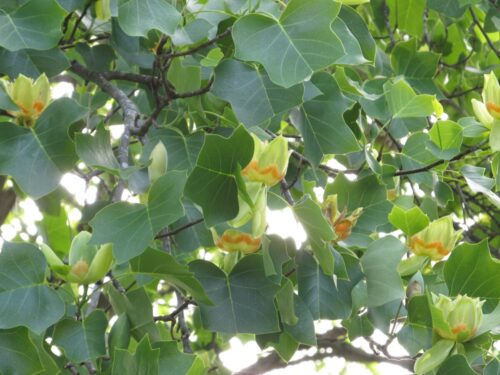A Pollinator Primer
March 28, 2022 1:31 pm
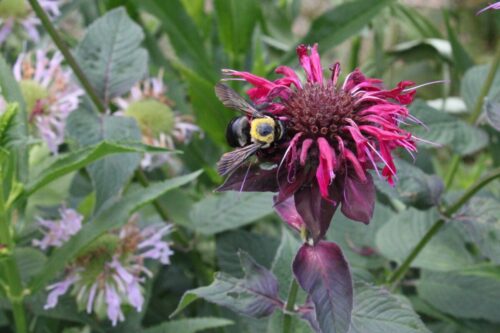
By Scott Bachman, DOF Senior Area Forester
Recently, I attended the Virginia Association of Forest Health Professionals meeting held in Staunton, VA. There were many great topics discussed over the day and a half long conference. I will admit I was there for the pesticide recertification credits I could earn. You never know what you will get when you attend a pesticide recertification meeting, but this agenda was quite varied and interesting. One speaker’s topic focused on butterflies, bumblebees and other pollinators. Pollinators are a common topic when pesticides are discussed, since we are so dependent on these insects for our own survival, and if proper precautions are not taken, they can be negatively affected by pesticides.
You probably know that cereal grains, such as corn, wheat, and other small grains, are wind-pollinated. This means they put their pollen on the breeze and hope that it makes its way to a receptive flower. A number of trees, such as maples, oaks, and pines, follow this same routine. This pollen storm is often held responsible for seasonal allergies, but that is a story for another post.
Fruit plants are rarely wind-pollinated. Instead, plants with “showy” flowers rely on the delivery of pollen from one plant to another by some other organism. These animals are collectively called pollinators. They come in all shapes and sizes – from bats to butterflies to bees!

A carpenter bee visits bee balm. (Photo: Ellen Powell)
Bees are probably the most well-known pollinators. Most of us probably think of bees as the things in the white boxes that farmers and fruit growers have around their fields to pollinate the crops. These managed hives are important for agriculture. They contain non-native European honey bees, whose “job” is to produce honey for the hive. Honey bees feed on nectar and pollinate flowers by accident. We take advantage of crop pollination as a side benefit.
Prior to the introduction of European honey bees, Virginia’s (and the continent’s) flowers relied exclusively on our great supply of native pollinating insects. Blueberries, blackberries, strawberries, and grapes were here and thriving long before the European colonization of North America. Forest trees like redbud, yellow-poplar, persimmon, magnolia and pawpaw were also thriving and could only do so if their flowers were pollinated.
- Pawpaw blooms in early spring. (Photo: Lisa Deaton)
- Yellow-poplar flowers are usually high in the canopy. (Photo: Ellen Powell)
Where did all these needed pollinators live? They don’t live in built bee boxes or even in hives in hollow trees, contrary to what Winnie the Pooh would like you to believe. Instead, they make their homes in the woods and glades of our natural lands. Bees are found in many different environments. Many of our native pollinators are solitary, meaning they do not create hives and colonies.
Where is this all leading? Shortly after attending the VAFHP meeting, my work unit completed a prescribed burn on a longleaf pine stand. The next day, my coworker and I went to check on the burn to make sure that it was completely contained. One area of mature timber that we burned was dotted with golf ball-sized mounds of fresh soil. They were very distinctive in the blackened forest floor. I assumed they were anthills until I saw a bit of movement. I stood still for a few moments and behold – a head appeared! It was not an ant, but a solitary ground-nesting bee! I cannot swear to the species, but a quick Google search led me to believe it was a Colletes inaequalis, a common ground-nesting bee in sandy soils. These are solitary bees, but that term is a bit misleading, considering there were hundreds of mounds in the area. The bees work on their nests independently, but they definitely like company nearby. This aggregation may increase their ability to successfully find mates and raise young.
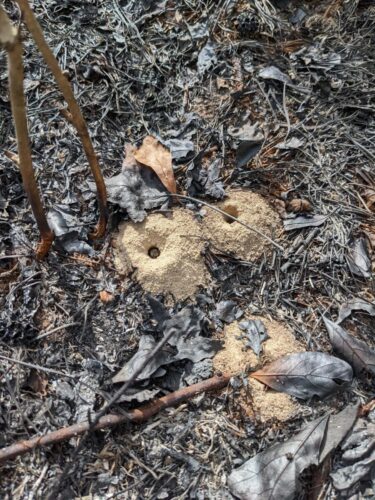
Look closely at the hole on the left – a solitary bee is emerging! (Photo: Scott Bachman)
These and other native bees are important to our crops and our forest plants. Native bees are excellent at spreading pollen. They often have “hairier” bodies than European honey bees. They do not make excess honey, so pollen is what they are after. They feed on the pollen and move to the next flower covered in that pollen. Inadvertently, they complete a step in the circle of life!
While you may not be familiar with ground-nesting bees, I am sure you are familiar with at least one native pollinating bee, the bumblebee. There are several species of bumblebees, but they are all similar. They typically have black and yellow and somewhat rounded bodies. Unlike most native bee species, bumblebees are not solitary insects. They do, however, demonstrate the fuzzy body of our native bees. When you next see a bumblebee watch it for a while. They can be so loaded up with pollen you may not even see the black marking on their bodies.
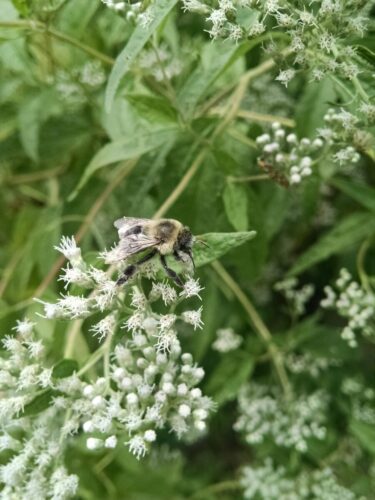
Bumblebee covered in pollen-grabbing fuzz (Photo: Ellen Powell)
While you may have an unpleasant memory or two of being stung by one of our native wasps like the yellow jacket (which are also important pollinators), solitary bees like the ones I saw are not aggressive and will generally not sting unless threatened. Female bees have stingers, which are modified ovipositors that have been weaponized. (Thanks to Dr. Jackson Means for that clarification.) Males do not have stingers, since they do not lay eggs. The solitary bees are not communal, so a swarm will not attack, even if you walk through the area of their nests.
Native bees can all use our help. As temperatures begin to warm and the juneberry, redbuds, and dogwoods begin to bloom, look out for the native solitary bees like C. inaequalis, bumblebees, and others as they go about their business and fill an important and unique niche. If you want to assist pollinators, you can, by planting native pollinator plants on your property. One good resource is the Audubon Society of Northern Virginia. Some native bees will even use nesting sites known as “bee houses.” DIY directions can be found on many sites.
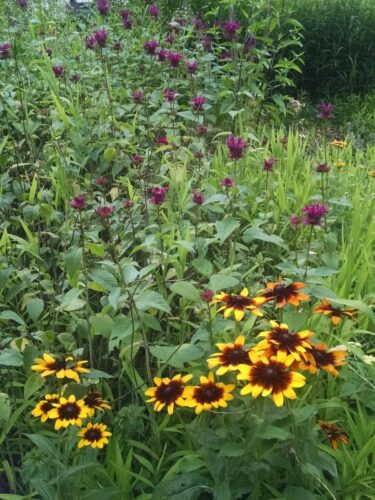
Pollinator garden (Photo: Ellen Powell)
Thanks to Kaitlin DeWitt, DOF Forest Health Specialist, for her editing and for reaching out to Dr. Jackson Means, Virginia Museum of Natural History. An entomologist, Dr. Means provided many of the biological and technical details about bees. I appreciate both of their assistance.
Tags: Insects, Native Species
Category: Education, Forest Health


